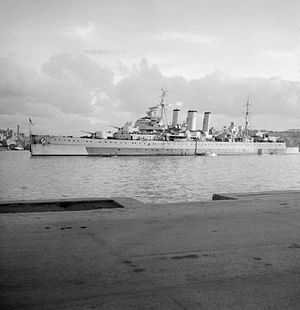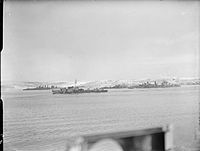HMS Cumberland (57)
This article includes a list of references, related reading, or external links, but its sources remain unclear because it lacks inline citations. (June 2008) |

| |
| History | |
|---|---|
| Name | HMS Cumberland |
| Builder | Vickers-Armstrong, Barrow in Furness |
| Laid down | 18 October 1924 |
| Launched | 16 March 1926 |
| Commissioned | 23 February 1928 |
| Recommissioned | 1951 |
| Decommissioned | 1946 |
| Fate | Sold for scrap 1959 |
| General characteristics | |
| Displacement | list error: <br /> list (help) 9,750 tons (9,010 t) standard 13,450 tons (13,670 t) full load |
| Length | 630 ft (190 m) |
| Beam | 68 ft 3 in (20.80 m) |
| Draught | 16 ft 3 in (4.95 m) |
| Propulsion | list error: <br /> list (help) Eight Admiralty 3-drum boilers Four shaft Brown Curtis geared turbines 80,000 shp |
| Speed | 31.5 knots (58.3 km/h) |
| Range | 3,100 nautical miles at 31.5 knots (5,740 km at 58 km/h), 13,300 nautical miles at 12 knots (24,600 km at 22 km/h); 3,400 tons (3,450 t) fuel oil |
| Complement | 679 (710 as flagship) |
| Armament | list error: <br /> list (help) Original configuration:
|
| Armour | list error: <br /> list (help) Original configuration:
|
| Aircraft carried | Three aircraft with one catapult, removed in 1942 |
| Notes | Pennant number 57 |
HMS Cumberland was a County class heavy cruiser of the Royal Navy that saw action during the Second World War.
Career
Cumberland served on the China Station with the 5th Cruiser Squadron from 1928 until 1938, returning to the UK in March 1935 for a refit. In 1938, she joined the 2nd cruiser squadron on the South American station.
In the South Atlantic
At the start of the Second World War in 1939, Cumberland was assigned to 2nd Cruiser Squadron Force G, the South American Division.[1] At the start of December she was forced to self-refit in the Falkland Islands, thus depriving the force of their strongest unit. Without her, HMS Exeter, Ajax and Achilles engaged the German raider Admiral Graf Spee in the Battle of the River Plate on 13 December. Cumberland received a garbled indication that a contact was being made and moved north to reinforce, arriving at the River Plate at 22:00 14 December, after steaming for 34 hours. The Graf Spee had put into neutral Montevideo and was trapped there, as Cumberland along with Ajax and Achilles (Exeter having been heavily damaged) patrolled the estuary, resulting in the Graf Spee being scuttled by her crew on 17 December.

South African service
After this she sailed to Simonstown, South Africa, spending between January and February undergoing a refit. She then escorted convoys along the African coast, bound for the Middle East. In July she was tasked, along with her sister, HMS Cornwall, with hunting down the German commerce raider Thor (known as Raider E to the Royal Navy). Whilst on patrol, she intercepted and sank the Vichy French merchant Poitiers, which had been carrying ammunition to the Ivory Coast. Later that month she attacked Dakar, suffering damage from a French coastal battery. In December, Cumberland was again hunting for the merchant raider Thor, but the search proved unsuccessful.
Arctic convoys
In October 1941 Cumberland joined the 1st Cruiser Squadron Home Fleet escorting the Arctic convoys until January 1944, winning the battle honour Arctic 1942-1943.
In the Far East

She was then transferred to the Far East, as part of 4th Cruiser Squadron Eastern Fleet. In September she carried out raids on Northern Sumatra. During this period, Cumberland won the battle honours Sabang 1944 and Burma 1945. On 7 February 1945, Cumberland was back in Simonstown to have her rudder removed.
Postwar
She returned to the United Kingdom on 12 November 1945 and transported troops until June 1946, when she was placed in reserve until 1949. She was then refitted at Devonport (1949-1951) for further service as a gunnery trials ship. She lost all of her 8" turrets, and for a few years a had a prototype dual 6" automatic turret (testing the concept for later installation in the then building Tiger class cruisers) in 'B' position, and a protoype automatic dual 3" turret (also slated for the Tigers) in 'X' position. For the 1956 film The Battle of the River Plate, Cumberland played both herself and Exeter (being partly disarmed) with the two experimental turrets fitted. Cumberland was finally decommissioned in 1958 and immediately sold for scrap.
In 1926 HMS Cumberland was the subject of a watercolour by distinguished maritime artist A.B.Cull. Although most of Cull's work was lost during air raids on Britain during the Second World War a number of works survived and now reside in the National Maritime Museum's collection. His study of HMS Cumberland, however, is held in a private collection in Australia.
References and notes
- ^ p.66, Boniface
Sources
- Boniface, Patrick, HMS Cumberland: A Classic British Cruiser in War and Peace, Periscope Publishing Limited, London, 2006
Further reading
- British and Empire Warships of the Second World War, H T Lenton, Greenhill Books, ISBN 1-85367-277-7
- Conway's All the World's Fighting Ships, 1922-1946, Ed. Robert Gardiner, Naval Institute Press, ISBN 0-87021-913-8
- Colledge, J. J.; Warlow, Ben (2006) [1969]. Ships of the Royal Navy: The Complete Record of all Fighting Ships of the Royal Navy (Rev. ed.). London: Chatham Publishing. ISBN 978-1-86176-281-8.
- HMS Cumberland at U-boat.net
